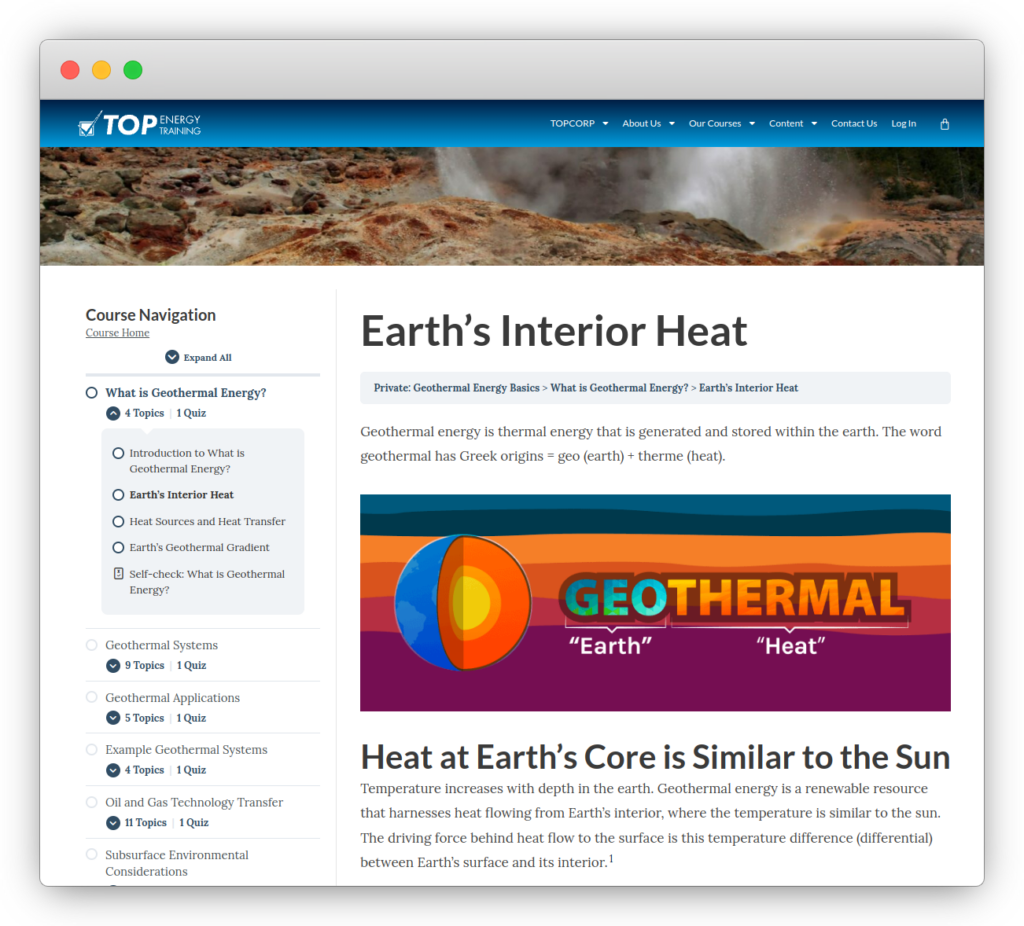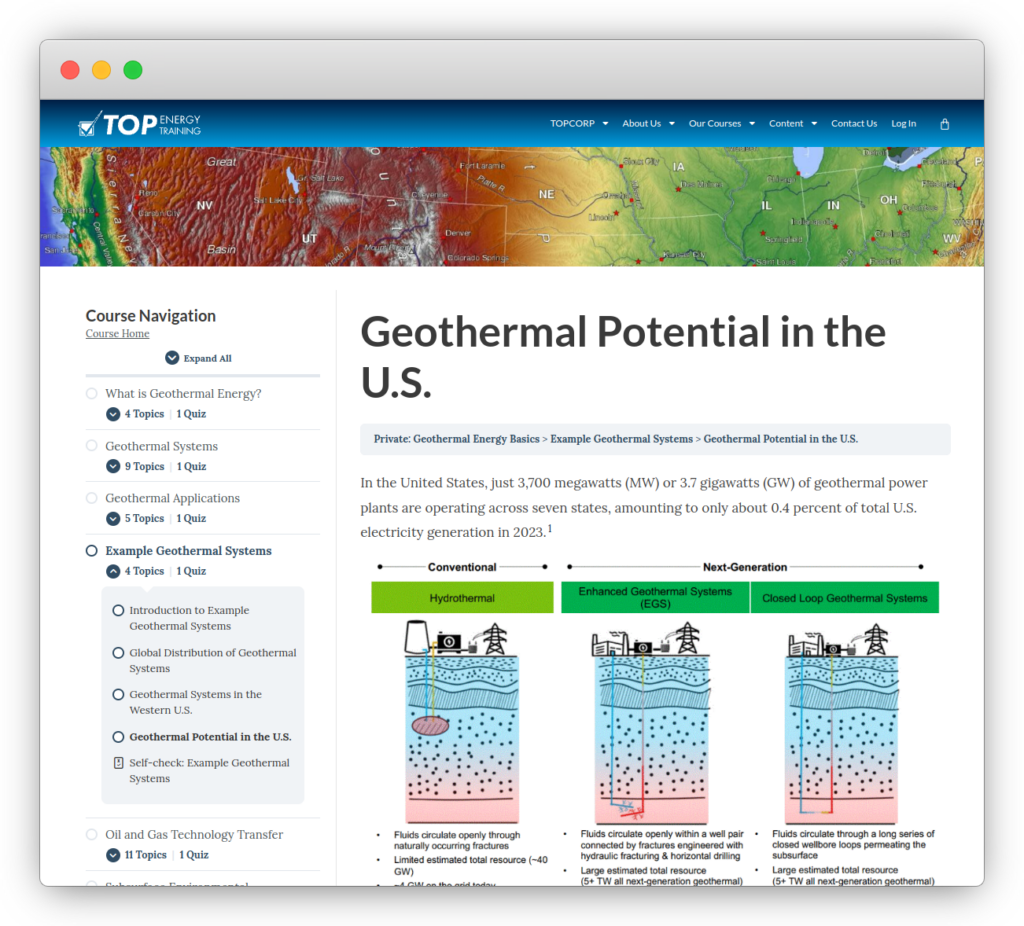Geothermal Energy Basics: Full Course
9 Lessons • 57 Topics
Do you have business interests in the energy sector? Maybe you’re looking to pursue a career in renewable energy? If so, you could benefit from TOP Energy Training’s online geothermal energy course. Like our oil and gas courses, our Geothermal Energy Basics course is designed to educate students and industry professionals on the latest technology innovations. This course covers the fundamentals of the science, engineering and technology behind geothermal energy systems, applications and field projects.
Not sure you want to invest in an entire course? Certain popular lessons are available for individual purchase. Take one of the course lessons to try it out. Your lesson cost can later be applied to the purchase of the full course if you like.
Geothermal Energy Basics Course Content Overview
The Geothermal Energy Basics course explains how and where earth’s heat is formed, as well as the various ways in which humans can harvest Earth’s natural, subsurface heat in the form of geothermal energy. Exploring different types of geothermal energy systems, as well as some of the more developed projects in the United States and around the world, highlights the future potential for geothermal power production and other geothermal application.
One of the exciting elements about geothermal energy is its alignment with much of the off-the-shelf oil and gas technology that has been perfected around the world. Drilling technology and hydraulic fracturing are key to many ‘next-generation’ geothermal projects. Even so, some system limitations have spurred additional technological development, such as the research and field projects discussed in this course.
Subsurface and surface environmental considerations with geothermal are much less than some other subsurface energy applications. In addition to the need for innovative technological development, environmental concerns that exist must be addressed in order for commercial liftoff of geothermal energy in the United States. A number of innovative projects discussed in the course demonstrate how the pathway is progressing.
The online … training was straightforward, and I enjoyed the ability to cover the material at my own pace. Information was highly specific and has enabled me to excel in my current profession.
—Tammy Shelton, Lead Technician, Railroad Commission of Texas


Lessons from the course
Created in conjunction with TOP Energy Training’s highly qualified instructors, each lesson encompasses multiple topics to sharpen your knowledge and technical proficiency.

What is Geothermal Energy?
4 Topics
How can humans harvest Earth’s natural, subsurface heat in the form of geothermal energy? Heat at Earth’s core is similar to the sun. The driving force to get this heat to the surface is the temperature differential between Earth’s surface and its interior. Heat travels via conduction and convection to the surface where humans can utilize this energy in a variety of ways. In areas where the geothermal gradient is greater, geothermal energy is most viable. These areas of high geothermal gradient can be predicted from patterns related to the geologic history of particular regions.

Geothermal Systems
9 Topics
Geothermal Systems vary widely depending upon the heat, fluid and flow capacity available to the system. In addition, systems that are considered naturally ‘imperfect’ can be engineered to meet the necessary criteria for economic projects.

Geothermal Applications
5 Topics
Geothermal applications of subsurface heat reservoirs include geothermal heat pumps, district heating and cooling, direct use and power generation. The current applications of geothermal energy shed light on its future potential to meet many of our energy needs. Geothermal applications have the potential to open the doors to a more sustainable energy future.

Example Geothermal Systems
4 Topics
Since the first documented awareness of geothermal resources several thousand years ago in Italy, the world has built up its geothermal power-generating capacity to ~16GWe. The United States is a leader in geothermal power generation, contributing ~24% of global geothermal electricity. An overview of global geothermal systems highlights the importance of the United States and other countries in their contributions to geothermal power capacity, but also the importance of geothermal as a key power generating primary energy source for certain communities. The U.S. Department of Energy’s goal is to achieve 125 GW of geothermal power-generating capacity by 2050. To gain commercial liftoff in the United States, some $20 billion of investment is required from government agencies, equity investors, corporate ventures and other capital providers.

Oil and Gas Technology in Geothermal
11 Topics
How similar are the activities of a geothermal project to an oil and gas project? Do oil & gas facilities, capabilities, and knowledge translate to geothermal projects?
Globally, an enormous storehouse of information & capability has been built up in the oil and gas sector over the last 100 years. One of the remarkable advantages that geothermal industry has over other renewable energy sources is that much of that storehouse can be used to rapidly accelerate the application and growth of the geothermal industry.

Subsurface Environmental Considerations
6 Topics
All energy sources have at least some environmental impact, although these impacts vary significantly in their intensity, persistence and form. Geothermal is considered by many to have the least impact of any energy source. The highlights of geothermal energy’s environmental advantages are lower lifecycle carbon emissions, a small surface footprint and low potential for water contamination. The main environmental concerns related to geothermal development and operations are the impact on water (consumption, contamination, and disposal) and the potential for induced seismicity and land subsidence.

Surface Environmental Considerations
6 Topics
All energy technologies, from traditional fossil based sources to renewables like solar and wind, have some environmental impact. Like many energy technologies, geothermal projects have environmental considerations and impacts at the surface. Careful project planning can reduce and mitigate these impacts.

Geothermal Power Plant Operations
5 Topics
There are three main types of geothermal power plant technologies; and the mechanism for converting the geothermal heat into electricity is part of the power plant design and generally depends on the state of the subsurface fluid and its temperature. Fluids management during geothermal plant operations is an important part of the project design. Based on geofluid content, some facilities could serve a dual purpose: extracting important minerals and generating geothermal power.

Innovative Geothermal Projects for the Future
7 Topics
Conventional geothermal, although always valued as a source of utility-scale clean firm power, has been dramatically constrained by its geographic limitations, relying on naturally-occurring thermal resources that only exist in niche locations. Engineers and scientists are looking to “next-generation” technologies to allow them to engineer effective geothermal resources in commonly found environments. Such new and innovative technologies would vastly expand resource availability and potential commercial adoption.
Each lesson has a self-assessment at the end to reinforce the information and prepare you for the next lesson.
Who Should Take This Course?
Professionals working in a variety of energy-related careers (e.g., engineers, geoscientists, attorneys, accountants, managers, regulatory personnel, policymakers) will be poised to take advantage of new opportunities by getting up-to-date with the latest science, technology and projects in the geothermal energy landscape. Students have a critical need to gain a solid foundation of geothermal fundamentals and distinguish their future college and/or employment applications. Educators want to present a broad perspective of the technical solutions within the subsurface energy industry to their students, highlighting the diverse nature of careers and opportunities within the energy sector.

